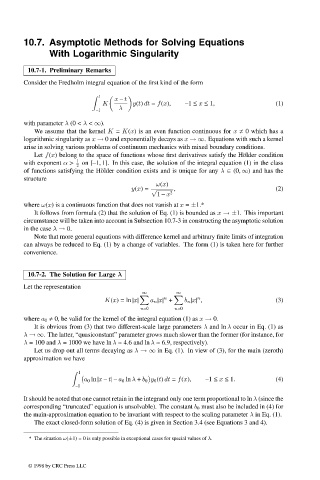Page 539 - Handbook Of Integral Equations
P. 539
10.7. Asymptotic Methods for Solving Equations
With Logarithmic Singularity
10.7-1. Preliminary Remarks
Consider the Fredholm integral equation of the first kind of the form
1 x – t
K y(t) dt = f(x), –1 ≤ x ≤ 1, (1)
–1 λ
with parameter λ (0 < λ < ∞).
We assume that the kernel K = K(x) is an even function continuous for x ≠ 0 which has a
logarithmic singularity as x → 0 and exponentially decays as x →∞. Equations with such a kernel
arise in solving various problems of continuum mechanics with mixed boundary conditions.
Let f(x) belong to the space of functions whose first derivatives satisfy the H¨ older condition
with exponent α > 1 on [–1, 1]. In this case, the solution of the integral equation (1) in the class
2
of functions satisfying the H¨ older condition exists and is unique for any λ ∈ (0, ∞) and has the
structure
ω(x)
y(x)= √ , (2)
1 – x 2
where ω(x) is a continuous function that does not vanish at x = ±1.*
It follows from formula (2) that the solution of Eq. (1) is bounded as x →±1. This important
circumstance will be taken into account in Subsection 10.7-3 in constructing the asymptotic solution
in the case λ → 0.
Note that more general equations with difference kernel and arbitrary finite limits of integration
can always be reduced to Eq. (1) by a change of variables. The form (1) is taken here for further
convenience.
10.7-2. The Solution for Large λ
Let the representation
∞
∞
K(x)=ln |x| a n |x| + b n |x| , (3)
n
n
n=0 n=0
where a 0 ≠ 0, be valid for the kernel of the integral equation (1) as x → 0.
It is obvious from (3) that two different-scale large parameters λ and ln λ occur in Eq. (1) as
λ →∞. The latter, “quasiconstant” parameter grows much slower than the former (for instance, for
λ = 100 and λ = 1000 we have ln λ ≈ 4.6 and ln λ ≈ 6.9, respectively).
Let us drop out all terms decaying as λ →∞ in Eq. (1). In view of (3), for the main (zeroth)
approximation we have
1
a 0 ln |x – t| – a 0 ln λ + b 0 y 0 (t) dt = f(x), –1 ≤ x ≤ 1. (4)
–1
It should be noted that one cannot retain in the integrand only one term proportional to ln λ (since the
corresponding “truncated” equation is unsolvable). The constant b 0 must also be included in (4) for
the main-approximation equation to be invariant with respect to the scaling parameter λ in Eq. (1).
The exact closed-form solution of Eq. (4) is given in Section 3.4 (see Equations 3 and 4).
* The situation ω(±1) = 0 is only possible in exceptional cases for special values of λ.
© 1998 by CRC Press LLC
© 1998 by CRC Press LLC
Page 521

